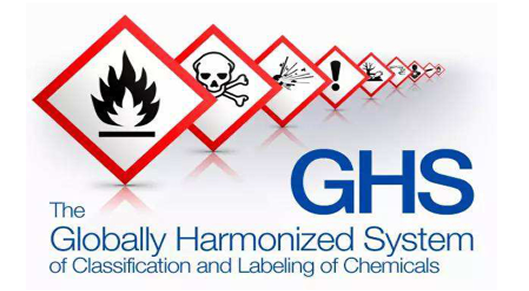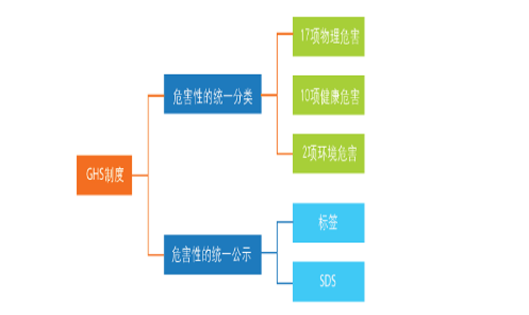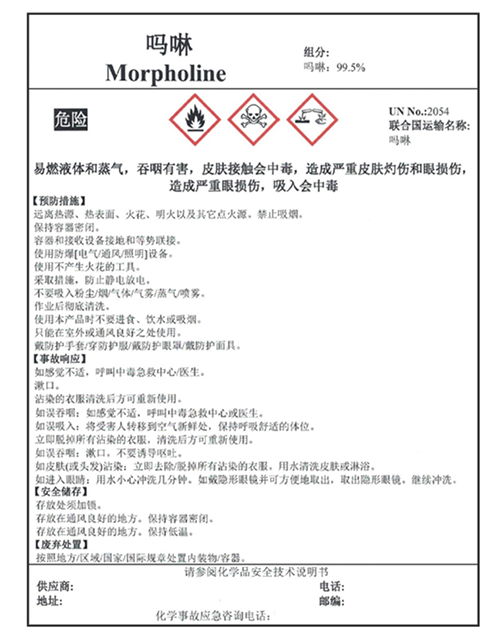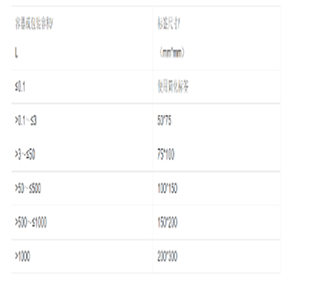
GHS stands for the Globally Harmonized System of Classification and Labelling of Chemicals, which mainly includes the Globally Harmonized System of Classification and Labelling of Chemicals, safety labels, and Safety Data Sheets (MSDS/SDS).
China GHS is a regulatory system composed of the "Regulations on the Safety Management of Hazardous Chemicals", "Measures for the Registration and Management of Hazardous Chemicals", national standards for classification, and national standards for the production of SDS and labels. Among them, the "Regulations on the Safety Management of Hazardous Chemicals" is the highest law governing China GHS.
According to the requirements of the above laws and regulations, all hazardous chemicals imported into China must be affixed with GHS Chinese public labels that meet the requirements, and UN packaging that complies with the United Nations International Maritime Dangerous Goods Code must be used. Otherwise, during the import of dangerous goods, the GHS labels and UN packaging will be confiscated and rectified, or the return policy will be implemented

Our company has 12 years of experience in dangerous goods import operations, familiar with the regulations and systems of the United Nations and various countries regarding GHS, proficient in the GHS label review system and process for dangerous goods import, and has long-term and good business cooperation with Yangshan Luchao Port Dangerous Warehouse, Shanghai Entry Exit Inspection and Quarantine Bureau Industrial and Raw Material Testing Technology Center, and Hangzhou Xike Testing Technology Co., Ltd.
Conduct compliance audits in advance based on the MSDS, cargo terminal, and labeling provided by the importer
Urgent agency GHS label identification report for audit issues
Quickly carry out services such as GHS labeling and UN packaging rectification in Yangshan hazardous warehouse
Including chemical identification, pictograms, signal words, hazard statements, prevention statements, emergency consultation hotline, supplier identification, information reference prompts, etc.
Use Chinese and English to indicate the chemical name and common name of the chemical, which should be prominent and clear, located above the label. The name should be consistent with the name in the chemical safety technical specification. For mixtures, the chemical name or common name, concentration, or concentration range of the main components that contribute to their hazard classification should be indicated. When there are a large number of components that need to be labeled, it is advisable to have no more than 5 components. For components that belong to trade secrets, they may not be labeled, but their hazards should be listed.
Adopt the pictographic diagram specified in GB 30000.X-2013.
According to the level and category of chemical hazards, use“ Danger” " Warning” Two words are used to warn of the degree of harm, and the signal word is located below the chemical name, requiring it to be prominent and clear. According to GB 30000.X-2013, select signal words for different categories of hazardous chemicals.
Briefly outline the hazardous characteristics of chemicals. Located below the signal word. Select hazard statements for different categories of hazardous chemicals according to GB 30000.X-2013

Express the precautions that must be taken during the disposal, handling, storage, and use of chemicals, as well as simple and effective first aid instructions in case of accidents. The content should be concise and focused. This section should include safety precautions, handling of unexpected situations (such as leaks, personnel contact, or fires), safety storage measures, and disposal of waste
Supplier name, address, postal code, and telephone number
Fill in the 24-hour chemical accident emergency consultation telephone number provided by the chemical manufacturer or the manufacturer's commission
There should be at least one 24-hour chemical accident emergency consultation hotline within China on the safety label of imported chemicals from abroad
Remind chemical users to refer to the chemical safety technical manual.
When a certain chemical has two or more hazards, the sequence of pictograms, signal words, and hazard statements on the safety label is specified as follows
2.9.1Sequence of pictograms
The order of physical hazard pictograms is determined according to the primary and secondary hazards in GB 12268. For chemicals not listed in GB 12268, the following hazard categories are always primary hazards: explosives, flammable gases, flammable aerosols, oxidizing gases, high-pressure gases, self reactive substances and mixtures, flammable substances, organic peroxides. The determination of other primary hazards is based on the method of determining the order of hazard in accordance with the United Nations Recommendations on the Transport of Dangerous Goods and the Model Regulations. For health hazards, the following order should be followed: if the loading and cross bone diagram opening symbol is used, there should be no exclamation mark graphic symbol; if the corrosion diagram symbol is used, there should be no exclamation mark to represent skin number or skin. Eye stimulation.
2.9.2Signal word order
When there are multiple hazards, if the signal word 'ldquo;' is selected on the safety label; Danger” If there is no signal word, it should not appear; Warning”
2.9.3Order of hazard statements
All hazard statements should appear on safety labels, arranged in the order of physical hazards, health hazards, and environmental hazards.
For chemical small packages of less than or equal to 100ml, for the convenience of label use, the safety label table can be simplified, including chemical identification, pictograms, signals, hazard statements, emergency consultation phone numbers, supplier names, and contact information.
The main body of the label should be expressed in simple, clear, easy to understand, and standardized Chinese characters. It is also possible to use minority languages or foreign languages at the same time, but the meaning must correspond to the Chinese characters, and the shape should be smaller than the Chinese characters. The same meaning should be represented using the same text or graphics
When new information is discovered about a certain chemical, the label should be revised in a timely manner.
The color of the pictograms inside the label shall be in accordance with the provisions of GB 30000.X-2013, generally using black graphic symbols with a white background and red square borders. The main text should use a contrasting color with the background, usually black and white. If used domestically, the square border can be black
For containers or packaging of different capacities, the minimum label size is shown in Table 1

4.4.1 A black border should be added to the edge of the label, leaving a blank space of 3mm or more outside the border, and the border width should be 1mm or more
4.4.2The shape diagram must be visible from a distance and under conditions of smoke or partially obscured containers.
4.4.3 The printing of labels should be clear, and the printing and adhesive materials used should have durability and waterproofness
5.1.1Safety labels should be affixed, hung, or sprayed in a prominent position on chemical packaging or containers
5.1.2When used in combination with a transport sign, the transport sign can be placed on the other side of the safety label, separated from other information, or placed near the safety label on the packaging. In the latter case, if the pictogram in the safety label overlaps with the transport sign, the pictogram in the safety label signature should be removed.
5.1.3For combination containers, it is required to attach (hang) safety labels on the inner packaging and transport pictograms on the outer packaging. If transport signs are not required, safety labels can be added
The regulations for the pasting and printing positions of safety labels are as follows:
a) Bucket and bottle shaped packaging: located on the side of the bucket or bottle
b) Box shaped packaging: located at a prominent position on the end or side of the packaging;
c) Bag and bundle packaging: located in a prominent position on the packaging.
5.3.1The pasting, hanging or printing of safety labels should be firm to ensure that they do not fall off or be damaged during transportation and storage
5.3.2Safety labels should be affixed, hung, or printed by the manufacturing enterprise before the goods leave the factory. If the packaging needs to be changed, the changing packaging unit shall re paste, hang or spray print the labels.
5.3.3Containers or packaging containing hazardous chemicals must be processed and confirmed to completely eliminate their hazards before the safety label can be removed. Otherwise, the corresponding label cannot be removed